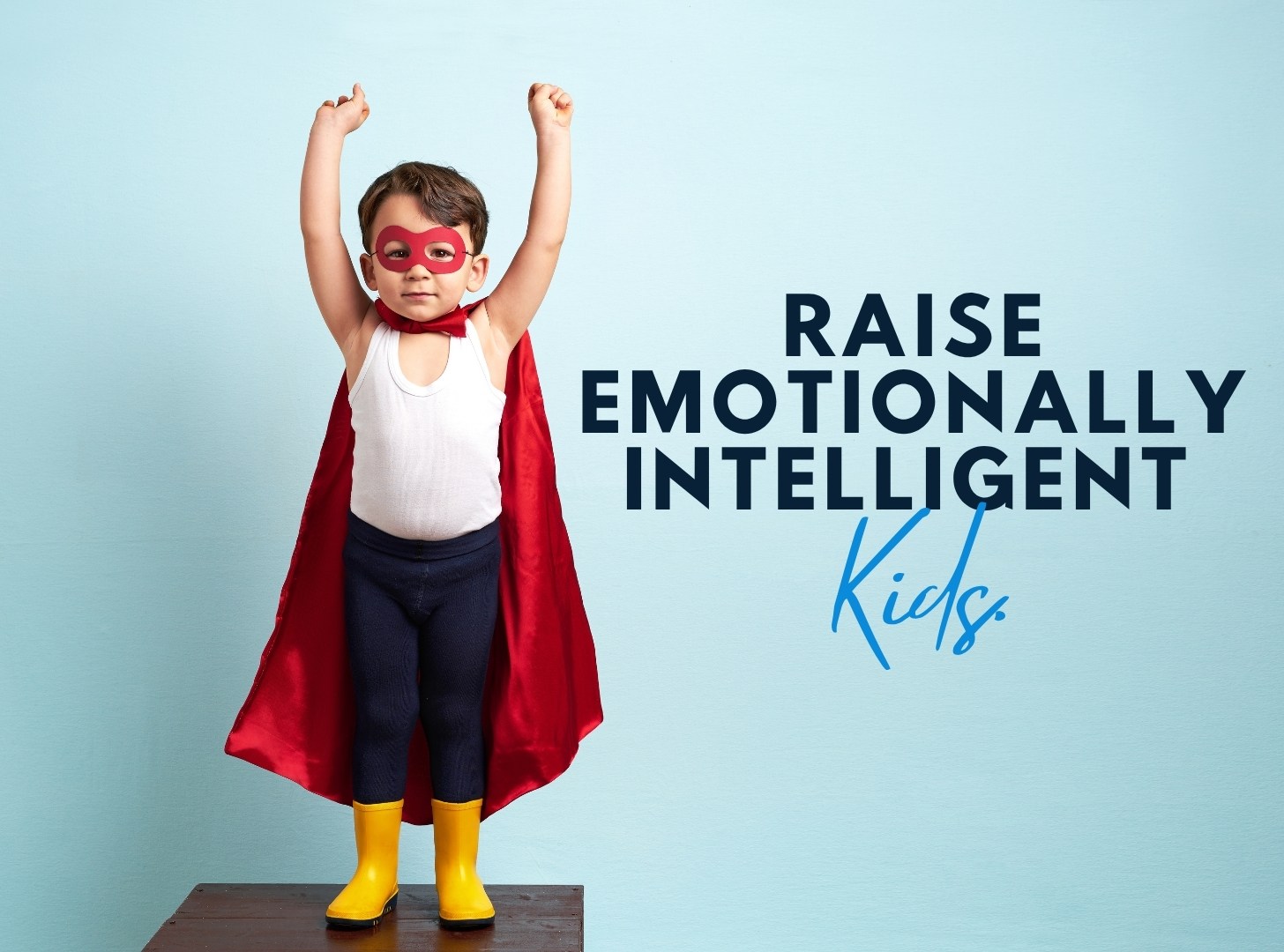
How to Raise Emotionally Intelligent Kids in a Digital World
In today’s fast-moving digital world, children are surrounded by screens, notifications, and constant stimulation. While technology connects us, it can also blur emotional boundaries.
Raising an emotionally intelligent child now means helping them recognize, express, and manage feelings in a world where genuine connection is often replaced by digital interaction.
Emotional intelligence for kids goes far beyond being polite or well-behaved. It’s the ability to understand emotions—both their own and others’—and use that understanding to make positive choices. Research suggests that emotional intelligence in children is linked to better relationships, enhanced learning, and improved mental health. Simply put, emotional intelligence is as important as academic intelligence for lifelong success.
Understanding Emotional Intelligence in Childhood
Emotional intelligence in childhood is the foundation of self-awareness, empathy, and resilience. According to researchers like Daniel Goleman, emotional intelligence includes five core skills: self-awareness, self-regulation, motivation, compassion, and social skills.
- Self-awareness helps children recognize their own emotions and understand them.
- Self-regulation enables them to manage their impulses and remain calm in challenging situations.
- Motivation gives them the persistence to face challenges,
- Empathy helps them understand the emotions of others.
- Social skills enable them to form healthy and supportive relationships.
These skills develop gradually through everyday interactions. Emotional intelligence in children develops when they feel safe expressing their emotions, when parents model calm behaviour, and when educators incorporate emotional learning into daily routines.
The Digital Dilemma: How Technology Shapes Feelings
While technology has made learning and communication easier, it also presents new emotional challenges. Children today may spend more time texting or gaming than having face-to-face conversations. This can limit their ability to read facial expressions, interpret tone, or respond empathetically.
Digital spaces can also amplify emotions. A single online comment can trigger anxiety or sadness, and the constant stream of likes and shares can affect self-esteem. Building emotional intelligence in children means teaching them to pause before reacting, to consider how their words impact others online, and to strike a balance between virtual experiences and real-world connections.
Parents can discuss with their children how they feel after using digital devices—whether it’s excitement, frustration, or loneliness—and guide them toward healthy online habits that support their emotional well-being.
How Can We Develop Emotional Intelligence in Children?
Developing emotional intelligence for children begins with modelling. Kids mirror how adults handle stress, disappointment, and joy. When parents calmly discuss their feelings or show empathy toward others, children learn to do the same.
Discuss emotions regularly. Simple questions like “How did that make you feel?” or “What could we do differently next time?” encourage reflection. Labeling emotions—such as happy, worried, frustrated, and proud—helps children understand that all feelings are valid and important.
Storytelling is another powerful tool. Discussing the emotions of book or movie characters helps children recognize feelings in themselves and others. By understanding the emotional causes and outcomes, individuals can build empathy and emotional awareness.
Building Emotional Intelligence in Kids
Emotional intelligence for kids doesn’t develop overnight; it grows through consistent practice and meaningful connection. When parents acknowledge their children’s emotions instead of dismissing them, children learn to accept themselves more readily. When they see calm problem-solving instead of shouting, they learn to control their emotions.
Encourage children to share how they feel after school or during conflicts. Rather than rushing to fix the problem, listen and validate their emotions. Statements like “I can see you’re disappointed” or “It’s okay to feel sad” teach that emotions are safe and normal.
Building emotional intelligence in kids also means encouraging empathy. Ask how others might feel in the same situation. This simple reflection develops compassion, one of the most vital emotional skills in both real and digital life.
How to Foster Emotional Intelligence in Preschoolers
The preschool years are an ideal time to start teaching emotional intelligence. At this age, children are learning to recognize basic emotions and manage their impulses. Using simple activities makes emotional learning enjoyable and memorable.
Parents can create a “feelings chart” with faces representing emotions such as happy, angry, or calm. Asking children to point to the picture that matches their mood helps them name and understand emotions. Reading picture books that explore feelings or playing games that involve sharing and assisting others can also strengthen empathy.
Even brief emotional check-ins, such as asking “What colour is your mood today?”—can make a significant difference. Early childhood experts recommend using visual tools, such as the mood meter from the RULER approach, developed at the Yale Centre for Emotional Intelligence. These tools help make emotions concrete and provide preschoolers with the language to express them safely.
Managing Emotions in a Digital World
Digital life offers endless excitement, but it also demands emotional balance. Parents play a crucial role in teaching children how to manage their online emotions. Encourage mindful screen use by setting times for digital breaks, family discussions, and creative offline play.
Talk about what happens when emotions rise online—such as feeling jealous after seeing someone’s post or angry during a video game. These moments are perfect opportunities to practice emotional regulation. Teach children to pause, breathe, and reflect before responding.
Helping children recognize that behind every message or emoji is a real person fosters digital empathy. When emotional intelligence guides online behaviour, kids learn kindness, respect, and self-control in every space they occupy.
Teaching Emotional Intelligence at Home and in School
Schools are increasingly incorporating emotional learning into the classroom. Programs like PATHS and RULER teach children to recognize and express emotions appropriately, as well as manage stress. Research shows that emotional intelligence in children enhances focus, cooperation, and academic achievement.
At home, parents can support these lessons by maintaining open communication about feelings. Talk about emotions at dinner, during car rides, or before bed. Share your own experiences—times when you felt nervous or proud—and discuss how you handled them. This helps children see that emotions are universal and manageable.
When teachers and parents collaborate in teaching emotional intelligence, children receive consistent support in understanding themselves and others.
Emotional Growth at Every Stage
Emotional development evolves with age. In preschool years, focus on recognizing and naming emotions. During elementary school, help children practice empathy and cooperation. By the teen years, emotional intelligence becomes essential for handling peer pressure, self-image, and digital communication.
Each stage offers new chances to guide your child toward emotional maturity. The more emotionally aware children become, the better they navigate challenges, build friendships, and develop confidence.
Conclusion: Raising Emotionally Wise Kids for a Digital Future
Raising an emotionally intelligent child is one of the most meaningful gifts a parent can give to their child. In a digital world filled with distractions, emotional awareness, empathy, and self-control are essential life skills that are crucial for success.
When families make space for honest conversations, mindful technology use, and empathy-driven actions, they help shape emotionally intelligent children who thrive both online and offline.
Emotional intelligence for kids isn’t just about understanding feelings—it’s about using those feelings to connect, create, and contribute to a kinder, more compassionate world.
Be the First to Know
Sign up for exclusive sneak peeks, ARC opportunities, reader discounts, and behind-the-scenes updates on upcoming releases.

